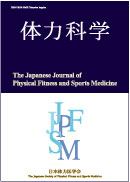
- Issue 6 Pages 223-
- Issue 5 Pages 183-
- Issue 4 Pages 149-
- Issue 3 Pages 97-
- Issue 2 Pages 63-
- Issue 1 Pages 1-
- |<
- <
- 1
- >
- >|
-
Takehiko Hasegawa, Sakura Ogawa, Shohei Dobashi, Toshinori YoshiharaArticle type: Original
2024Volume 73Issue 3 Pages 97-110
Published: June 01, 2024
Released on J-STAGE: May 15, 2024
JOURNAL OPEN ACCESSThis study aimed to elucidate the effects of long-term high-fat diet (HFD) consumption and cage restriction-induced physical inactivity (IN) during youth on skeletal muscle autophagy in rats. Three-week-old male Wistar rats were randomly assigned to two dietary groups: the normal diet (ND) and HFD groups. Each group was further subdivided into control (CON) and IN conditions, resulting in four experimental groups (n = 7-8). The HFD group was provided with a diet containing approximately 60% of total calories from crude fat for 16 weeks, from 4 to 20 weeks of age. The ND group received a standard diet for the same duration. The physical inactivity intervention during youth involved restricting the rats’ range of activity by housing them in smaller cages for eight weeks. After 12 weeks of age, the behavioral restrictions were lifted, and all groups of rats were housed in normal-sized cages for eight weeks. The ‘diet group’ and ‘condition’ factors exerted significant effects on the relative muscle weight of the gastrocnemius muscle. The HFD groups exhibited a notable decline in relative muscle weight compared to their ND counterparts. While no significant alterations were observed in LC3-II or p62 expression levels, the ‘diet group’ factor significantly influenced LC3-II/I levels in the white gastrocnemius muscle. These levels were markedly reduced in the HFD group. Our findings suggest that 16 weeks of HFD consumption leads to a reduction in autophagy flux, specifically within the white portion of the gastrocnemius muscle, but this effect is not influenced by cage restriction-induced physical inactivity during youth.
View full abstractDownload PDF (3944K) -
Makoto Okada, Tadashi Nakazawa, Shigeki IzumiArticle type: Original
2024Volume 73Issue 3 Pages 111-121
Published: June 01, 2024
Released on J-STAGE: May 15, 2024
JOURNAL OPEN ACCESSWe conducted a large-scale survey of sports injuries in college athletes. This study aimed to investigate trends in sports injuries and disabilities among college athletes by gender, discipline, individual and team competition, contact and noncontact competition, and other competition characteristics. A total of 1,137 college athletes (786 men and 351 women) were surveyed. A questionnaire survey was conducted to determine the club, regularity, and history of sports injuries and disorders (presence/absence, severity, time of injury, site of injury, diagnosis, and recurrence). The prevalence of sports injuries among college athletes was 59.7%. The prevalence was 74.7% in team and contact sports, with ankle and knee ligament injuries accounting for most injuries. The second highest prevalence rate was 66.7% for individual/contact sports, where martial arts-type sports are common. Elbow injuries were common due to the characteristics of martial arts-type sports. Chronic sports injuries of the ankle were common in noncontact/individual sports, and shoulder joint disorders were common in noncontact/team sports. Different trends in sports injuries and disabilities were found depending on the sport characteristics. Considering the characteristics of the sports is necessary to prevent sports injuries and disabilities.
View full abstractDownload PDF (1247K)
-
Takeshi Otsuki, Kazuya Suwabe, Sumiyo Shiina, Toru Yoshikawa, Asako Ze ...Article type: Material
2024Volume 73Issue 3 Pages 123-131
Published: June 01, 2024
Released on J-STAGE: May 15, 2024
JOURNAL OPEN ACCESSIn Japan, where the population is aging, it is important to train exercise instructors who promote health in older adults. Previous studies demonstrated that an intergenerational program that was not focused on exercise improved university students’ perceptions of older adults, but the effects of an intergenerational exercise-related program have not been explored. This study investigated whether obtaining experience in providing exercise instruction to older adults improved university students’ attitudes toward these adults and their willingness to acquire exercise instruction-related qualifications. Second-year university students majoring in sport and health sciences were divided into intervention (n = 29) or control (n = 33) groups. Students in the intervention group participated in a 5-session program that involved choreographing exercise with music and giving exercise instructions to community-dwelling older adults. In the final session, the students and older adults performed the exercise together, and this session was videotaped. Explicit attitudes toward older adults improved from before to after the program in the intervention group. The percentage of students in the intervention group who were willing to acquire exercise instruction-related qualifications was greater after the program than before it. In the control group, there were no detectable differences in these measures before and after the study period. Students’ feelings (i.e., vitality, stability, pleasure, and arousal) acutely improved after each session in the intervention group. These results may imply that after experiencing the provision of exercise instruction to older adults, university students’ explicit attitudes toward these adults and their willingness to obtain exercise instruction-related qualifications were increased.
View full abstractDownload PDF (1135K)
-
2024Volume 73Issue 3 Pages 133-134
Published: 2024
Released on J-STAGE: May 15, 2024
JOURNAL OPEN ACCESSDownload PDF (599K)
-
2024Volume 73Issue 3 Pages 135-136
Published: 2024
Released on J-STAGE: May 15, 2024
JOURNAL OPEN ACCESSDownload PDF (584K) -
2024Volume 73Issue 3 Pages 137-144
Published: 2024
Released on J-STAGE: May 15, 2024
JOURNAL OPEN ACCESSDownload PDF (979K) -
2024Volume 73Issue 3 Pages 145-148
Published: 2024
Released on J-STAGE: May 15, 2024
JOURNAL OPEN ACCESSDownload PDF (795K)
- |<
- <
- 1
- >
- >|